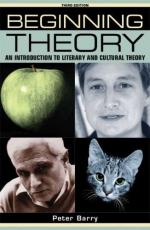|
This section contains 477 words (approx. 2 pages at 400 words per page) |

|
Theory before theory - liberal humanism Summary and Analysis
The Church of England monopolizes English studies through Oxford and Cambridge Universities where only men attend and the teachers are unmarried ordained ministers. Until the 1820s education includes classics, divinity and mathematics, and is unchanged since the Middle Ages. In 1826 a charter is granted to award degrees to men and women. By 1828 English becomes a school subject and in 1829 the first Professor of English is appointed. English teaching is proposed at first to maintain political status and substitute for religion. In the 1920s Cambridge teaching adapts to teachers like Richards, Empson and Leavis. I.A Richards teaches "Practical Criticism" that isolates literary text from the context of history and is used as a current standard. William Empson identifies seven difficulties in poetry and F.R. Leavis takes a moral approach that...
(read more from the Theory before theory - liberal humanism Summary)
|
This section contains 477 words (approx. 2 pages at 400 words per page) |

|




